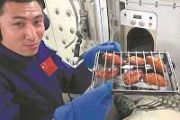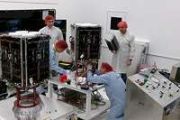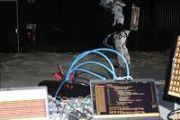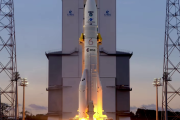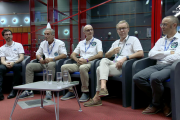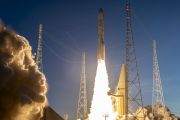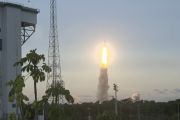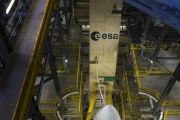
Copernical Team
Astroscale's ELSA-d demonstrates repeated magnetic capture
 Astroscale's End-of-Life Services by Astroscale-demonstration (ELSA-d) successfully tested its ability to capture its client spacecraft using the servicer's magnetic capture system, in a demonstration performed on Wednesday, August 25 (UTC).
A major challenge of debris removal, and on-orbit servicing in general, is docking with or capturing a client object; this test demonstration served a
Astroscale's End-of-Life Services by Astroscale-demonstration (ELSA-d) successfully tested its ability to capture its client spacecraft using the servicer's magnetic capture system, in a demonstration performed on Wednesday, August 25 (UTC).
A major challenge of debris removal, and on-orbit servicing in general, is docking with or capturing a client object; this test demonstration served a Orbit Logic adds augmented reality to SpyMeSat
 Orbit Logic's award-winning SpyMeSat mobile app (available in the Apple App Store and Google Play) now includes an augmented reality (AR) interface for better awareness of overflying imaging satellites!
The AR view overlays the orbit and position of satellites that can image your location, providing a better understanding of satellite viewing geometry and potential obstructions; e.g., to k
Orbit Logic's award-winning SpyMeSat mobile app (available in the Apple App Store and Google Play) now includes an augmented reality (AR) interface for better awareness of overflying imaging satellites!
The AR view overlays the orbit and position of satellites that can image your location, providing a better understanding of satellite viewing geometry and potential obstructions; e.g., to k SwRI tests liquid acquisition device aboard Blue Origin's New Shepard rocket
 A Southwest Research Institute (SwRI) experiment was performed aboard Blue Origin's New Shepard suborbital rocket, which launched from Van Horn, Texas Thursday. Five variations of the tapered liquid acquisition device (LAD), which is designed to safely deliver liquid propellant to a rocket engine from fuel tanks, were aboard the rocket to evaluate their performance in microgravity.
The tap
A Southwest Research Institute (SwRI) experiment was performed aboard Blue Origin's New Shepard suborbital rocket, which launched from Van Horn, Texas Thursday. Five variations of the tapered liquid acquisition device (LAD), which is designed to safely deliver liquid propellant to a rocket engine from fuel tanks, were aboard the rocket to evaluate their performance in microgravity.
The tap Space Systems Command declares three GPS III space vehicles "Available for Launch"
 The U.S. Space Force's Space Systems Command recently declared the eighth GPS III satellite as "Available for Launch." This significant accomplishment officially marks the third space vehicle within the GPS III program to be declared available for launch in the past three months.
GPS III SV06, SV07, and SV08 are now awaiting official call up for launch in Lockheed Martin's GPS III Processi
The U.S. Space Force's Space Systems Command recently declared the eighth GPS III satellite as "Available for Launch." This significant accomplishment officially marks the third space vehicle within the GPS III program to be declared available for launch in the past three months.
GPS III SV06, SV07, and SV08 are now awaiting official call up for launch in Lockheed Martin's GPS III Processi SpaceX launches Dragon Cargo mission to ISS
 A SpaceX rocket from Florida carrying part of a robot that could help perform routine tasks for astronauts on the International Space Station was launched early Sunday morning from the launch pad at Kennedy Space Center.
Launch of the resupply mission, with 4,800 pounds of goods for the space station, was at 3:14 a.m. EDT Sunday.
The robotic arm is the feature of the resupply mission
A SpaceX rocket from Florida carrying part of a robot that could help perform routine tasks for astronauts on the International Space Station was launched early Sunday morning from the launch pad at Kennedy Space Center.
Launch of the resupply mission, with 4,800 pounds of goods for the space station, was at 3:14 a.m. EDT Sunday.
The robotic arm is the feature of the resupply mission Astra rocket fails after liftoff from Alaska
 California-based Astra Space, a small, relatively new rocket company, failed in flight Saturday after a launch from Alaska supported in part by the U.S. Space Force.
The rocket "suffered an anomaly" about 2 1/2 minutes after liftoff from Kodiak shortly after 6:30 p.m. EDT, the company said, not elaborating on what happened.
The failure followed an aborted attempt the day before,
California-based Astra Space, a small, relatively new rocket company, failed in flight Saturday after a launch from Alaska supported in part by the U.S. Space Force.
The rocket "suffered an anomaly" about 2 1/2 minutes after liftoff from Kodiak shortly after 6:30 p.m. EDT, the company said, not elaborating on what happened.
The failure followed an aborted attempt the day before, SpaceX launch of robotic arm to space station reset for Sunday
 Launch of a SpaceX rocket from Florida carrying part of a robot that could help perform routine tasks for astronauts on the International Space Station was postponed early Saturday morning because of storms near the launch pad at Kennedy Space Center.
"Weather is not in our favor today," SpaceX production supervisor Andy Tran said during a live webcast of the launch attempt. "The vehicl
Launch of a SpaceX rocket from Florida carrying part of a robot that could help perform routine tasks for astronauts on the International Space Station was postponed early Saturday morning because of storms near the launch pad at Kennedy Space Center.
"Weather is not in our favor today," SpaceX production supervisor Andy Tran said during a live webcast of the launch attempt. "The vehicl Unravelling the mystery of brown dwarfs
 Brown dwarfs are astronomical objects with masses between those of planets and stars. The question of where exactly the limits of their mass lie remains a matter of debate, especially since their constitution is very similar to that of low-mass stars. So how do we know whether we are dealing with a brown dwarf or a very low mass star?
An international team, led by scientists from the Unive
Brown dwarfs are astronomical objects with masses between those of planets and stars. The question of where exactly the limits of their mass lie remains a matter of debate, especially since their constitution is very similar to that of low-mass stars. So how do we know whether we are dealing with a brown dwarf or a very low mass star?
An international team, led by scientists from the Unive How disorderly young galaxies grow up and mature
 Using a supercomputer simulation, a research team at Lund University in Sweden has succeeded in following the development of a galaxy over a span of 13.8 billion years. The study shows how, due to interstellar frontal collisions, young and chaotic galaxies over time mature into spiral galaxies such as the Milky Way.
Soon after the Big Bang 13.8 billion years ago, the Universe was an unruly
Using a supercomputer simulation, a research team at Lund University in Sweden has succeeded in following the development of a galaxy over a span of 13.8 billion years. The study shows how, due to interstellar frontal collisions, young and chaotic galaxies over time mature into spiral galaxies such as the Milky Way.
Soon after the Big Bang 13.8 billion years ago, the Universe was an unruly Collins Aerospace to provide an Earth-like atmosphere for future travelers heading into orbit
 Collins Aerospace has been awarded a $2.6 million contract by an undisclosed customer for Environmental Control and Life Support Systems (ECLSS) that will support a mission to establish a privately owned and operated orbital outpost in low Earth orbit.
The ECLSS is a suite of technologies that enable livable conditions as low as 250 kilometers above Earth's surface. The ECLSS includes air
Collins Aerospace has been awarded a $2.6 million contract by an undisclosed customer for Environmental Control and Life Support Systems (ECLSS) that will support a mission to establish a privately owned and operated orbital outpost in low Earth orbit.
The ECLSS is a suite of technologies that enable livable conditions as low as 250 kilometers above Earth's surface. The ECLSS includes air 

